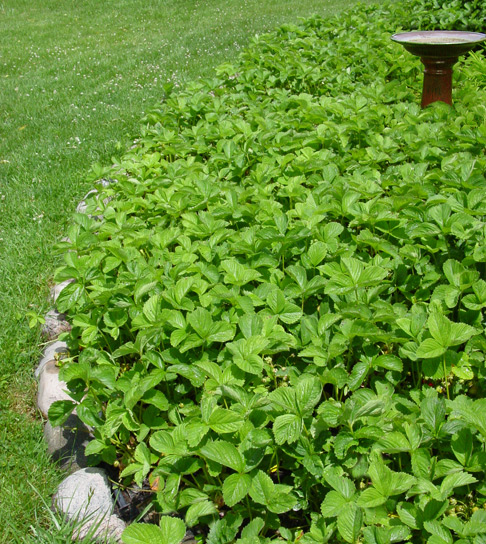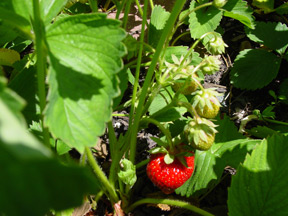Strawberries are a rewarding fruit crop that will produce for many years in the home garden. All you need is a small space with sunshine, reasonably good soil and a gardener willing to water when the weather is dry. Strawberries need 1-2 inches of water each week and this is especially important from early bloom to end of harvest.
In choosing your strawberry plants, remember that there are basically three types to consider and that each type has a few different varieties. Your local Cooperative Extension will have recommendations for strawberry varieties that should do well in your specific area.
June Bearing – these plants produce a single, large crop of berries in June. Most berries ripen out within a 3 week period. These traditionally grown plants produce a single flush of flowers and many runners and they generally produce the largest berries of the three types. I planted the “Honeoye” variety, which was highly recommended and I am very happy with my choice. During June we live in strawberry heaven with strawberries in our salads and on our desserts. I freeze a lot of berries, share some with family and friends and my sister uses some to make strawberry wine. I would recommend this variety to anyone who wants a huge single crop.
Everbearing – these plants produce 2 – 3 harvests of fruit spread out during spring, summer and fall and do not send out nearly as many runners. My mom used to grow these, we got a longer season, but fewer berries for each harvest. This type is better for someone who has no interest in canning or freezing berries, but wants berries for their morning cereal and on their evening dessert.
Day Neutral – these plants produce fruit throughout the growing season and do not have many runners. I tried these in my garden, but noticed that the berries were smaller and not plentiful. I think these might be good if you have a small space or are gardening in pots.
Garden Tips for Planting Strawberries — Taken from Research
- Schedule planting for early spring or late fall
- Be careful to choose certified disease-free plants
- Amend soil in new strawberry bed with organic matter
- Make planting hole large enough to spread strawberry plant roots. Hill up center of hole and place crown a bit above soil level. Spread roots downward on hill. Fill hole, making sure crown of plant is above soil level and water thoroughly.
- Mulch between plants to keep soil temperatures down and deter weeds
In my garden, I followed all of these directions. However, the last time I had purchased straw mulch there were a lot of weed seeds mixed in and of course, being weeds, they all sprouted and grew. My strawberry garden became a big weedy mess. So, when I replanted the strawberry bed, I didn’t want to make the same mistake and so was at a loss about how to proceed. My new plants were growing, but so were weeds, hundreds of them.
Finally, I decided to use the lasagna method of placing wet newspapers around each strawberry plant to smother the weeds as I had done in the perennial garden. Then, because I needed soil for the runners to grow in, I covered the newspapers with composted cow manure that I purchased in our local garden center instead of wood chips. Well that idea really worked! The strawberry runners put down their little roots and the whole bed filled in with new plants.
That replanting was done last year and so far, I have hardly any weeds. This is year two for the new bed and I have a bumper crop of strawberries ripening out, so many in fact that we are having the grandkids over to let them try picking strawberries!
Now I know that in a couple of years my newspapers will rot down and disappear and that process will improve my garden soil. Probably I will have weeds again, but since strawberry beds get replanted every few years, I will just repeat my lasagna mulch idea when that time comes!
Don’t you just love it when a new idea actually works!






I love this mulch idea! I just planted a strawberry bed a few weeks ago and have not yet put down straw. I can’t wait to do the lasagna method. Thanks for the great idea!
That strawberry patch is remarkable! I bet there are hundreds of wonderful berries hiding just below those leaves! GREAT!